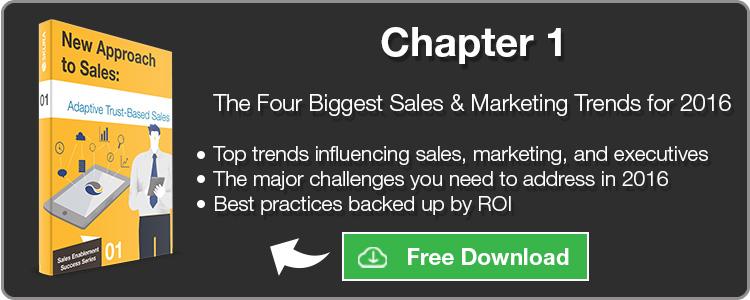When you’re working the front lines of sales or marketing, integrated marketing communications challenges can be a daily hurdle.
Trying to plan the right content, map buyer personas, distribute material and coordinate IMC, analyze consumption, etc. tends to reveal obvious gaps in technological capability that aren’t mitigated by current marketing and sales stacks.
The challenge for many isn’t finding the right solution, but rather, convincing the key decision maker to invest in a tool or solution that you need. Today we look at 3 steps to earn executive buy-in for sales enablement software (and other purchases).
A quick google search reveals several tips and lists to earn management buy-in for a change of strategy or investment in new technology, but as I’m sure many have found, they can be self-serving, lack focused value to your specific situation, and don’t make it easier to have that important 'final' discussion.
1) Adapt the Message to the Receiver
This is a crucial first step to communicating needs within your digital sales process. The Harvard Business Review found that many focus too much on content, and not enough on delivery.
A study of 1600 business executives revealed 5 distinct decision making styles. Although personalities can overlap across styles, tough high-stakes that involve multiple considerations tend to push people towards one style.
80% of sales presentations focus on the ‘skeptic’ and the ‘controller’ style, meanwhile these two styles only account for 28% of the executive population.

(Image Source: Market8)
A brief overview of the styles:
Charismatics represents 25% of decision makers. They are talkative and impressed with intelligence and facts. They won’t usually give in to self-absorption, and will seek out facts to support their emotions. If none can be found, they’ll quickly lose interest, and they are keen on bottom-line results. Keep arguments simple, and be honest and upfront with risks.
Thinkers represent 11% of decision makers. They are the most difficult to understand and toughest to persuade. They’re impressed with quantitative arguments supported by data. They have two strong desires – to anticipate and to win. You want to leverage all pertinent data, market research, case studies, etc. Most importantly, focus on the methodology used in getting from point A to point B in your argument.
Skeptics represent 19%. They are highly suspicious of every data point, especially when it challenges their view. They have strong combative personalities, which means you’ll need to build credibility before you go into the discussion. Thankfully skeptics are the easiest to spot, they love to move forward with groundbreaking ideas, just be sure to earn trust first.
Followers are the largest group with 36% of decision makers. They fear making the wrong choice and their decisions are based on past similar decisions. They’re seldom the early adopters, but will agree with something when it’s been done elsewhere. Followers can be the hardest to classify but easiest to persuade. They are persuaded by confidence, examples of past success, proven methods, and references.
Controllers are the last group and represent 9% of executives. They like pure facts and detest ambiguity or uncertainty. They’re described as logical, unemotional, sensible, and detail-oriented. Though they seek accuracy and facts, they aren’t necessarily prone to making rational decisions. You need structured, linear arguments. Winning a controller means less about selling, and more about helping them come to the conclusion on their own.
Source and more information for the decision maker style at Harvard Business Review.
2) Plan Your Delivery
Once you know ‘who’ you’re dealing with, you want to take some time to plan how you’re going to communicate the message.
Here are two great resources to get you started.
Power-point deck for influencing action on an issue.
Power-point deck for suggesting a change to current actions.
A presentation isn’t necessarily the only strategy, but it does offer the best structure.
[RELATED CONTENT] Looking for hard stats on the challenges and trends influencing sales and marketing in 2016? Click the link for a FREE copy of our eBook and start putting together your case for holistic sales enablement.
3) Build Your Case
This is where many executive buy-in guides tend to start. Now that you have an idea of who you’re tying to convince and how you’re going to deliver the message it's time to start putting together your case.
Consult your internal team members, understand their challenges, and construct a group of supporters. If your proposed change influences the daily lives of others, they should be part of the process.
Don’t allow silo thinking to limit your view. Sales enablement software is just as important for marketers as it is for sales, use this opportunity to bring groups together through the tech you want.
Address the current situation of your resources and needs. If your business invests in a suite of sales stack technologies, consider reviewing the stack and identifying replaceable elements that can be mitigated by a more holistic solution.
Consider the other technology your business uses, and how a new investment like sales enablement can add additional value to those systems, such as a CRM.
Show how and why the solution matters to the executives. Recall the range of decision maker personality types from above, your choice of key points must reflect their value drivers.
In our next post we’ll provide reasons why sales enablement is beneficial for executive decision makers. We’ll link that article HERE when released. Subscribe to our mailing list for an instant notification on release.
Are you trying to get an executive decision maker on board with sales enablement software? Struggling to get the message across? Request a demo and let us help you craft an impactful argument for future proof digital content sales.












